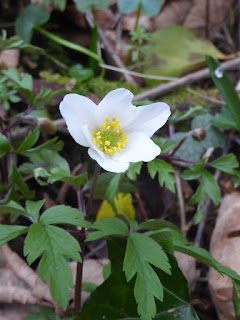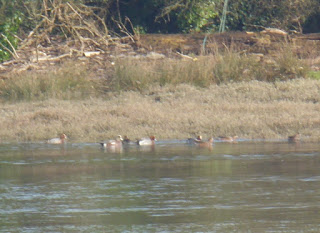Wednesday 1st February and an early start to catch the 7:30 bus to Torcross for a birding walk at Slapton Ley on a grey and breezey morning with the occassional sunny spell. I was feeling knackered after working 2 long days in a row and I am not sleeping particularly well at the moment, I have no trouble getting to sleep but can't stay asleep, I wake up in the early hours and just can not drop off again. I had thought about catching the 9:00 bus instead and trying to sleep in longer but as usual I was awake early anyway and with rain forecast for the afternoon I headed off on the early bus as originally planned.
Arriving at Torcross at around 9:20 and I had a quick scan around, noting year ticks in gadwall and great crested grebe amongst the tufted duck and coot flocks on the water. An immature male scaup was a nice find, also new for the year, it was busily preening before diving and despite searching I never refound it. However as I scanned around looking for it I immediately picked up a large adult gull with a Daz white head and mid-grey upperwings amongst the herring, common, lesser black backed and great black backed gulls - a very smart adult yellow legged gull, my second in a week! I often find this with my birding, I see a new or uncommon or scarce bird and then very soon after see another.
It really stood out amongst the gull flock, its white head almost gleaming and with grey upperwings coloured between the paler herring gulls and darker lesser black backed gulls nearby. Bill chunkier and very bright yellow with a bright red spot compared to gulls nearby, bright yellow legs seen when it leapt up off the water as it bathed and limited white in its wing tips when it eventually flew off - cue some more crappy photos!
Yellow Legged Gull (top), Lesser Black Backed Gull (middle), Herring Gull (bottom)
Yellow Legged Gull (top)
Yellow Legged Gull (upper right)
Yellow Legged Gull
Yellow Legged Gull - upper right
Yellow Legged Gull- upper left
Yellow Legged Gull taking off
Yellow Legged Gull with Herring Gulls
Yellow Legged Gull - upper right
Yellow Legged Gull - flashing its yellow legs
Yellow Legged Gull behind a Lesser Black Backed Gull
Yellow Legged Gull - wingtips
After the yellow legged gull flew off I had another scan around for the elusive scaup but still couldn't find it and just as I was about to start my walk towards the Upper Ley a small gull flying towards the duck feeding area caught my eye. I thought it was an immature juvenile kittiwake as it had a dark black W across its upperwings but as it got nearer its small size was apparent - a 1st winter little gull!
It splashed down amongst the black headed gulls and mallards just a few metres away and had a bathe and a preen for a few minutes before flying off - amazing views of the worlds smallest gull and well worth my early start ( and I had also already seen the worlds largest gull, the great black backed gull).
1st Winter Little Gull
Little Gull
Little Gull
Little Gull
Little Gull
Little Gull
Little Gull with Black Headed Gull
Little Gull with Black Headed Gull
I eventually started my walk towards the bridge between the Upper and Lower Leys and along the way saw a pair of stonechat, a meadow pipit, a small flock of around 6 long tailed tits and a Cettis warbler which showed very well in the reeds as it gave a wren like alarm call before disappearing.
Mid Ley and I eventually found 2 adult male and a female scaup amongst a small group of tufted duck and pochard, the female was definently a greater scaup as there have been reports of a potential female lesser scaup present on the Ley.
Female Scaup
Female Scaup
Male Scaup
Male Scaup
From the Memorial car park I quickly found the wintering black necked grebe very close to the beach on a choppy sea along with a great northern diver, both year ticks, and there were quite a few gannets flying around, some very close in and flying along the beach.
Black Necked Grebe
Great Northern Diver
In Ireland Bay I found 4 male and 3 female goldeneye amongst the duck flock, the 4th male being unpaired and busily displaying to the paired females without any success. 12 little grebes and a male teal were also seen but best of all was a female marsh harrier soaring over the reeds before heading off down the Ley.
From the bridge a firecrest gave some excellent views as it bathed in the water and then
preened in the willows before flying off and at least 3 water rails were squealing in the reed beds but I couldn't catch sight of one.
David duly arrived in the car and after parking up at the bridge we walked to Torcross for some lunch. I had another scan offshore from the memorial car park where there were now 2 great northern divers close to shore with a guillemot further out but there was no sign of the black necked grebe. A brief view of a dark fin very close to the beach was a surprise and as I scanned around I picked out at least 3 harbour porpoise in the breakers, the closest to shore I have ever seen porpoises before.
At Torcross a grey seal poked its head out of the breakers, again very close to the beach, and after some lunch in the pub we walked back to the bridge as the rain began to fall, noting the 2 male scaup again mid Ley and a group of around 30 gannets diving for fish off the memorial car park very near to the beach - obviously there was some very good fishing close to shore today.
And so an excellent day out - the birding Gods really smiled on me and I guess I was in the right place at the right time for some very good sightings.








































































